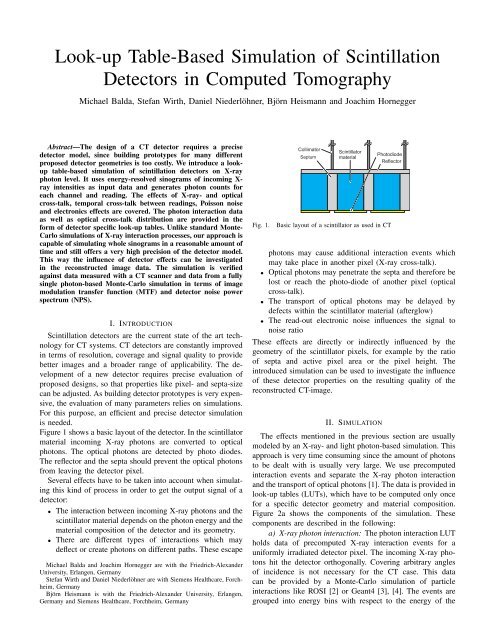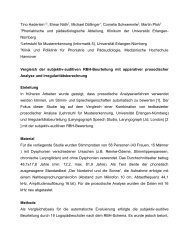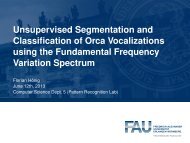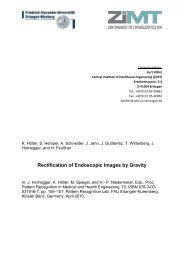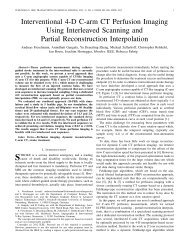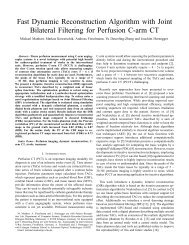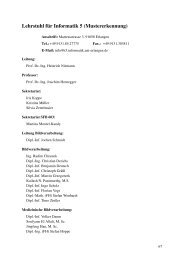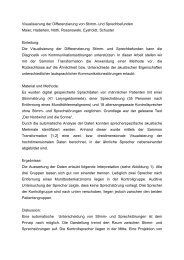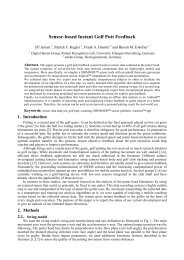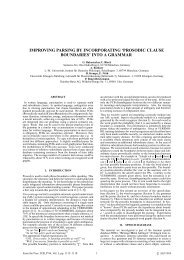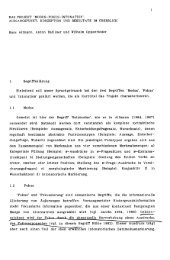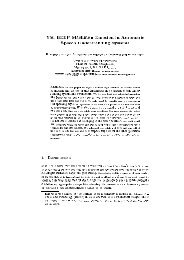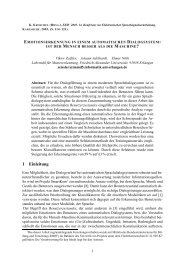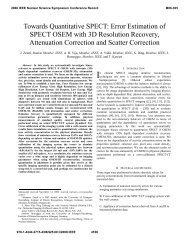Look-up Table-Based Simulation of Scintillation ... - ResearchGate
Look-up Table-Based Simulation of Scintillation ... - ResearchGate
Look-up Table-Based Simulation of Scintillation ... - ResearchGate
You also want an ePaper? Increase the reach of your titles
YUMPU automatically turns print PDFs into web optimized ePapers that Google loves.
<strong>Look</strong>-<strong>up</strong> <strong>Table</strong>-<strong>Based</strong> <strong>Simulation</strong> <strong>of</strong> <strong>Scintillation</strong><br />
Detectors in Computed Tomography<br />
Michael Balda, Stefan Wirth, Daniel Niederlöhner, Björn Heismann and Joachim Hornegger<br />
Abstract—The design <strong>of</strong> a CT detector requires a precise<br />
detector model, since building prototypes for many different<br />
proposed detector geometries is too costly. We introduce a look<strong>up</strong><br />
table-based simulation <strong>of</strong> scintillation detectors on X-ray<br />
photon level. It uses energy-resolved sinograms <strong>of</strong> incoming X-<br />
ray intensities as input data and generates photon counts for<br />
each channel and reading. The effects <strong>of</strong> X-ray- and optical<br />
cross-talk, temporal cross-talk between readings, Poisson noise<br />
and electronics effects are covered. The photon interaction data<br />
as well as optical cross-talk distribution are provided in the<br />
form <strong>of</strong> detector specific look-<strong>up</strong> tables. Unlike standard Monte-<br />
Carlo simulations <strong>of</strong> X-ray interaction processes, our approach is<br />
capable <strong>of</strong> simulating whole sinograms in a reasonable amount <strong>of</strong><br />
time and still <strong>of</strong>fers a very high precision <strong>of</strong> the detector model.<br />
This way the influence <strong>of</strong> detector effects can be investigated<br />
in the reconstructed image data. The simulation is verified<br />
against data measured with a CT scanner and data from a fully<br />
single photon-based Monte-Carlo simulation in terms <strong>of</strong> image<br />
modulation transfer function (MTF) and detector noise power<br />
spectrum (NPS).<br />
I. INTRODUCTION<br />
<strong>Scintillation</strong> detectors are the current state <strong>of</strong> the art technology<br />
for CT systems. CT detectors are constantly improved<br />
in terms <strong>of</strong> resolution, coverage and signal quality to provide<br />
better images and a broader range <strong>of</strong> applicability. The development<br />
<strong>of</strong> a new detector requires precise evaluation <strong>of</strong><br />
proposed designs, so that properties like pixel- and septa-size<br />
can be adjusted. As building detector prototypes is very expensive,<br />
the evaluation <strong>of</strong> many parameters relies on simulations.<br />
For this purpose, an efficient and precise detector simulation<br />
is needed.<br />
Figure 1 shows a basic layout <strong>of</strong> the detector. In the scintillator<br />
material incoming X-ray photons are converted to optical<br />
photons. The optical photons are detected by photo diodes.<br />
The reflector and the septa should prevent the optical photons<br />
from leaving the detector pixel.<br />
Several effects have to be taken into account when simulating<br />
this kind <strong>of</strong> process in order to get the output signal <strong>of</strong> a<br />
detector:<br />
• The interaction between incoming X-ray photons and the<br />
scintillator material depends on the photon energy and the<br />
material composition <strong>of</strong> the detector and its geometry.<br />
• There are different types <strong>of</strong> interactions which may<br />
deflect or create photons on different paths. These escape<br />
Michael Balda and Joachim Hornegger are with the Friedrich-Alexander<br />
University, Erlangen, Germany<br />
Stefan Wirth and Daniel Niederlöhner are with Siemens Healthcare, Forchheim,<br />
Germany<br />
Björn Heismann is with the Friedrich-Alexander University, Erlangen,<br />
Germany and Siemens Healthcare, Forchheim, Germany<br />
Fig. 1.<br />
Collimator<br />
Septum<br />
Scintillator<br />
material<br />
Photodiode<br />
Reflector<br />
Basic layout <strong>of</strong> a scintillator as used in CT<br />
photons may cause additional interaction events which<br />
may take place in another pixel (X-ray cross-talk).<br />
• Optical photons may penetrate the septa and therefore be<br />
lost or reach the photo-diode <strong>of</strong> another pixel (optical<br />
cross-talk).<br />
• The transport <strong>of</strong> optical photons may be delayed by<br />
defects within the scintillator material (afterglow)<br />
• The read-out electronic noise influences the signal to<br />
noise ratio<br />
These effects are directly or indirectly influenced by the<br />
geometry <strong>of</strong> the scintillator pixels, for example by the ratio<br />
<strong>of</strong> septa and active pixel area or the pixel height. The<br />
introduced simulation can be used to investigate the influence<br />
<strong>of</strong> these detector properties on the resulting quality <strong>of</strong> the<br />
reconstructed CT-image.<br />
II. SIMULATION<br />
The effects mentioned in the previous section are usually<br />
modeled by an X-ray- and light photon-based simulation. This<br />
approach is very time consuming since the amount <strong>of</strong> photons<br />
to be dealt with is usually very large. We use precomputed<br />
interaction events and separate the X-ray photon interaction<br />
and the transport <strong>of</strong> optical photons [1]. The data is provided in<br />
look-<strong>up</strong> tables (LUTs), which have to be computed only once<br />
for a specific detector geometry and material composition.<br />
Figure 2a shows the components <strong>of</strong> the simulation. These<br />
components are described in the following:<br />
a) X-ray photon interaction: The photon interaction LUT<br />
holds data <strong>of</strong> precomputed X-ray interaction events for a<br />
uniformly irradiated detector pixel. The incoming X-ray photons<br />
hit the detector orthogonally. Covering arbitrary angles<br />
<strong>of</strong> incidence is not necessary for the CT case. This data<br />
can be provided by a Monte-Carlo simulation <strong>of</strong> particle<br />
interactions like ROSI [2] or Geant4 [3], [4]. The events are<br />
gro<strong>up</strong>ed into energy bins with respect to the energy <strong>of</strong> the
Optical Photon<br />
Distribution LUT<br />
Input Intensity<br />
Sinogram<br />
X-Ray Photon<br />
Interaction LUT<br />
<strong>Simulation</strong> Process<br />
Readings<br />
Thread 1 Thread 2 ... Thread n<br />
Photon Count<br />
Sinogram<br />
Afterglow /<br />
Electronics Post-Processing<br />
Output<br />
Sinogram<br />
I -reading<br />
0<br />
D<strong>up</strong>licate<br />
<strong>Simulation</strong><br />
Average<br />
Reconstruction<br />
Slice Image<br />
Input Sinogram<br />
Mask<br />
<strong>Simulation</strong><br />
Unmask<br />
Calculate<br />
Attenuation<br />
Values<br />
Attenuation<br />
Value Sinogram<br />
Metadata<br />
Fig. 2.<br />
(a) Basic simulation layout<br />
Signal flow diagrams for detection- and complete CT scan simulation<br />
(b) Workflow for slice image generation with masking for<br />
complete CT scan simulation<br />
corresponding incoming photon. We chose to have one million<br />
events available for all energy bins <strong>of</strong> 5 keV width. One event<br />
contains an arbitrary amount <strong>of</strong> interaction data-sets, since an<br />
incoming photon might not interact at all or might produce<br />
one or more interactions. An interaction data-set contains the<br />
following entries:<br />
• Relative 2D detector pixel location <strong>of</strong> the interaction<br />
(non-zero in case <strong>of</strong> X-ray cross-talk)<br />
• Number <strong>of</strong> generated optical photons (depends on the<br />
deposited energy <strong>of</strong> the interaction)<br />
• Discrete 3D location within the scintillator element. The<br />
location is quantized to a discrete voxel position v within<br />
the pixel.<br />
Figure 3 visualizes the LUT-data for two energy bins at<br />
25 keV and 100 keV. Figure 3a shows the interaction locations<br />
and the respective energy deposition <strong>of</strong> several thousand<br />
100 keV events. The photon interction LUT stores the interactions<br />
positions in quantized form as 3D-voxel coordinates.<br />
Figures 3(b) and (c) show two histogramms <strong>of</strong> the energy<br />
deposition within the scintillator material with respect to the<br />
interaction voxel indices. For this case we used 20 × 20 × 20<br />
voxels in phi-, z- and depth-direction for each scintillator pixel.<br />
The figure only shows the central voxels with respect to the<br />
z-direction. This data is computed for a photon interaction<br />
LUT that contains 10 6 X-ray photons (events) per energy<br />
bin. Energy deposited within the septa is discarded and the<br />
corresponding interactions are not stored in the LUT as they<br />
do not contribute to the output signal. The figures show that<br />
most <strong>of</strong> the energy is deposited in the scintillator <strong>of</strong> the illuminated<br />
pixel and, as expected, the energy deposition decreases<br />
exponentially with increasing depth. The neighboring pixels<br />
show the energy deposition due to X-ray cross-talk as they<br />
are not exposed to direct radiation. Here the energy deposition<br />
does not show such a clear dependence on depth, but decreases<br />
with distace to the center pixel.<br />
b) Optical photon distribution: The optical cross-talk is<br />
modeled as a set <strong>of</strong> two-dimensional distribution functions<br />
d v (x p ) for each discrete position v within the pixel. d v (x p )<br />
yields the probability that an optical photon released at v<br />
reaches the photo-diode at relative pixel position x p . As the<br />
intensity <strong>of</strong> the optical cross-talk drops exponentially with the<br />
distance to the originating pixel, it is sufficient to limit d v (x p )<br />
to a small region. A significant amount <strong>of</strong> optical photons<br />
does not reach a photo-diode pixel, therefore ∑ x p<br />
d v (x p ) is<br />
smaller than 1. The data needed for this look-<strong>up</strong> table can be<br />
acquired using a light transport simulation [5]. With this data<br />
we form a so called optical photon distribution LUT, which<br />
contains a distribution function for each voxel center <strong>of</strong> the<br />
interaction LUT.<br />
The total amount <strong>of</strong> optical photons generated in one interaction<br />
is distributed over pixels within the neighborhood with<br />
the respective LUT-entries as weighting factors. Poisson noise<br />
is applied to the optical photon numbers <strong>of</strong> each event and<br />
pixel. Figure 4 shows the typical properties <strong>of</strong> this LUT by<br />
comparing the detection probabilities for some specific voxel<br />
locations. Figure 4a shows the probability distribution for the<br />
center voxel on a log scale. The influence <strong>of</strong> the interaction<br />
location on the optical cross-talk can be seen in the absolute
detection probablities as well as the amount <strong>of</strong> cross-talk in<br />
the respective neighboring pixels: Figure 4b shows only a<br />
slight shift in the detection probability if an optical photon is<br />
created on the very right or left edge <strong>of</strong> the scintillator pixel<br />
at the same depth. The influence <strong>of</strong> the depth <strong>of</strong> interaction<br />
is considerably larger (see Fig. 4c): Photons created far <strong>of</strong>f<br />
the photo diode have a high cross-talk probablity and are less<br />
likely to be detected at all.<br />
c) Input data: For a complete scan simulation the input<br />
sinogram contains data for all channels and readings. This<br />
data consists <strong>of</strong> mean values <strong>of</strong> incoming X-ray photons at<br />
specific energies. The input sinograms can be computed by<br />
an analytic projection tool like NCAT4D [6]. For this purpose<br />
geometric phantoms have to be defined. For each ray from<br />
the focal spot <strong>of</strong> the X-ray tube to the detector pixels the<br />
according lengths within the phantom materials are computed.<br />
The total attenuation for the ray can then be estimated using<br />
the attenuation coefficients <strong>of</strong> the phantom materials and<br />
the corresponding intersection lengths. These attenuations are<br />
applied to an appropriate tube spectrum. It contains the X-ray<br />
photon counts per energy. Information about how to acquire<br />
tube spectra can be found in [7].<br />
d) <strong>Simulation</strong> process: The simulation consists <strong>of</strong> the<br />
following steps:<br />
1) Get the mean number <strong>of</strong> incoming X-ray photons for<br />
each channel, reading and energy level<br />
2) Apply Poisson distributed noise<br />
3) For each X-ray photon, pick random event and get<br />
all interactions (Gives the number <strong>of</strong> created optical<br />
photons and voxel locations <strong>of</strong> interactions)<br />
4) For each interaction: Distribute the optical photons to the<br />
according photo-diode pixels using the matching optical<br />
photon distribution LUT entries<br />
5) Apply Poisson distributed noise to optical photon counts<br />
at photo-diode prior to adding to the output signal <strong>of</strong> the<br />
respective pixels<br />
The result <strong>of</strong> this process are optical photon counts at each<br />
photo diode pixel.<br />
The process can be parallelized for subsequent readings to<br />
utilize multiple processors and/or multi-core processors. The<br />
run-time <strong>of</strong> the simulation is linearly dependent <strong>of</strong> the total<br />
number <strong>of</strong> incoming X-ray photons <strong>of</strong> all detector channels<br />
and read-outs per channel. The energy distribution <strong>of</strong> the<br />
incoming X-ray photons can have a minor influence on the<br />
simulation run-time as the average number <strong>of</strong> interactions<br />
varies with X-ray photon energy.<br />
e) Electronics and afterglow post-processing:<br />
Electronics properties like quantization or amplifier noise<br />
additionally influence the measurement. These effects can be<br />
modeled as a post-processing step on the photon count data.<br />
Scintillator afterglow is modeled as temporal cross-talk<br />
between subsequent measurements. It cannot be handled<br />
within the simulation process as it does not resolve temporal<br />
behavior. So if the simulation <strong>of</strong> afterglow effects is desired,<br />
it is treated in a post-processing step as well. It consists<br />
<strong>of</strong> convoluting the measurement signal <strong>of</strong> each channel<br />
at multiple readings with an appropriate impusle response<br />
function that models the afterglow characteristics. In this<br />
case, a sum <strong>of</strong> decaying exponential functions can be used.<br />
The model parameters can be acquired by measuring the<br />
afterglow characteristics <strong>of</strong> the scintillator material [8].<br />
We use the following optional speed-<strong>up</strong> techniques:<br />
f) Masking: The computation time is linearly dependent<br />
on the total amount <strong>of</strong> incoming X-ray photons. For simulating<br />
whole CT-scans most time is spent on simulating sinogram<br />
regions that are exposed to direct radiation even though<br />
these regions contain little information. In many cases the<br />
computation time can be reduced by masking those regions<br />
prior to simulation. This can be done by compairing the input<br />
sinogram with an i 0 -reading which is only exposed to direct<br />
radiation. It is necessary to simulate at least one i 0 -reading for<br />
a full scan simulaton, since it is needed to convert measured<br />
intensities into attenuation values. This enables us to unmask<br />
the result using the simulated i 0 -reading. It is recommended<br />
to simulate multiple i 0 -readings for two reasons: First <strong>of</strong> all<br />
a low-noise i 0 -reading is needed to generate a sinogram <strong>of</strong><br />
attenuation values from intensity values, secondly varying i 0 -<br />
readings can be used for unmasking, otherwise the same noise<br />
pattern would repeat in the unmasked regions. Precomputed i 0 -<br />
reading results may be re-used for later simulations with same<br />
detector geometry and X-ray tube settings. Figure 2b shows<br />
a diagram containing all necessary steps for a complete CT<br />
scan simulation including masking and i 0 simulation.<br />
g) Total cross-talk simulation: The usage <strong>of</strong> a total crosstalk<br />
LUT <strong>of</strong>fers the possibility to trade accuracy for speed.<br />
The total cross-talk LUT combines X-ray photon interaction<br />
and optical photon transport properties. It contains numbers<br />
<strong>of</strong> detected optical photons in a defined neighborhood around<br />
an illuminated pixel for a fixed amount <strong>of</strong> incoming X-ray<br />
photons. This LUT can be computed in advance from the<br />
photon interaciton LUT and the optical photon distribution<br />
LUT data for a very large amount <strong>of</strong> incoming X-ray photons.<br />
This is done separately for each energy bin to preserve the<br />
energy dependence <strong>of</strong> the input data. This LUT <strong>of</strong>fers only<br />
one total optical photon distribution for each energy bin.<br />
The usage <strong>of</strong> this LUT requires the following steps for each<br />
channel, reading and energy bin <strong>of</strong> the input data:<br />
1) Retrieve the number <strong>of</strong> detected optical photons in each<br />
pixel within the neighborhood <strong>of</strong> the current channel<br />
(look-<strong>up</strong> in total cross-talk LUT)<br />
2) For each pixel in this neighborhood: Scale this value<br />
with respect to the number <strong>of</strong> X-ray photons in the<br />
current energy bin <strong>of</strong> the input data<br />
3) Apply Poisson noise<br />
4) Add the resulting value <strong>of</strong> detected optical photons to<br />
the respective pixel signal <strong>of</strong> the output data<br />
The decision for this using LUT or the spearated X-ray<br />
interaction and optical photon transport LUTs can be triggered<br />
with a threshold: If the amount <strong>of</strong> incoming X-ray photons<br />
exceeds the threshold within an energy bin, the scaled values<br />
<strong>of</strong> the total cross-talk LUT can be used to directly calculate<br />
the amount <strong>of</strong> optical photons reaching the neighboring photodiodes.<br />
This approach is several orders <strong>of</strong> magnitude faster<br />
than computing the optical cross-talk separately for each X-<br />
ray photon. Its time consumption is independent <strong>of</strong> the X-ray
(a) (b) (c)<br />
Fig. 3. (a) Interaction locations <strong>of</strong> 2500 X-ray photon events (100 keV) and excerpt <strong>of</strong> the histogramm <strong>of</strong> energy deposition within scintillator voxels for<br />
equidistributed irradiation <strong>of</strong> center pixel with monoenergetic X-ray photons. Central slice in z-direction is shown. (b) 25 keV photons, (c) 100 keV photons.<br />
Fig. 4.<br />
(a) Optical photon distributions for top center<br />
region <strong>of</strong> scintillator pixel<br />
(b) Comparison between rightmost and leftmost<br />
voxel with respect to phi-direction (central<br />
depth- and z-coordinate)<br />
Optical photon distribution-LUT example and comparisons between voxel positions<br />
(c) Comparison between topmost and bottommost<br />
voxel with respect to interaction depth<br />
(central phi- and z-coordiante)<br />
flux and depends linearly on the number <strong>of</strong> detector channels<br />
and read-outs per channel. However, it does not <strong>of</strong>fer the high<br />
precision <strong>of</strong> the approach using separated LUTs. The threshold<br />
value can be used to steer the trade-<strong>of</strong>f between speed and<br />
precision.<br />
III. RESULTS<br />
We evaluate two possible applications <strong>of</strong> this type <strong>of</strong> simulation:<br />
The estimation <strong>of</strong> the detector NPS and the image<br />
MTF. All results presented in the following section are based<br />
on simulations <strong>of</strong> Gd 2 O 2 S:Pr scintillators. The X-ray photon<br />
interaction events were precomputed using a proprietary particle<br />
interaction simulation.<br />
Image MTF comparison: With this experiment we examine<br />
the principal possibility to conduct complete CT<br />
scan simulations with this simulation framework. A 672-<br />
channel detector <strong>of</strong> 64 rows with 1.3 mm phi-pitch and<br />
1.1 mm z-pitch was simulated. The results were compared<br />
to measured data <strong>of</strong> a Siemens Sensation 64 CTscanner.<br />
A high-contrast phantom was used (Catphan 500,<br />
http://www.phantomlab.com/catphan.html). The<br />
phantom contains inlays <strong>of</strong> line-patterns with increasing number<br />
<strong>of</strong> line pairs per cm (lp/cm). It is used the estimate the<br />
frequency resolution <strong>of</strong> the reconstructed image.<br />
Figure 5a shows a comparison <strong>of</strong> measured and simulated<br />
image MTFs for a body reconstruction kernel. The average<br />
error <strong>of</strong> the simulated MTF in the range <strong>of</strong> 1 to 10 lp/cm<br />
is 3.68%. This kind <strong>of</strong> simulation, however, includes many<br />
parameters that are not related to the detector like tube and<br />
reconstruction properties. Therefore we performed further tests<br />
that focus on the detector properties.<br />
Detector NPS estimation: In order to verify the<br />
simulation performance independently <strong>of</strong> the influence <strong>of</strong><br />
other system parameters we compute the detector noise power<br />
spectrum (NPS) from simulated and measured data. The NPS<br />
can be computed from the detector signal resonse to an X-ray<br />
flat-field. It contains information on the signal noise level and<br />
the modulation transfer characteristics <strong>of</strong> the detector.<br />
First we compare simulated NPS results <strong>of</strong> our look-<strong>up</strong> tablebased<br />
approach with those <strong>of</strong> a fully single-photon based<br />
Monte-Carlo simulation. Both do not include electronics<br />
simulation. The later approach is very precise but extremely<br />
time consuming and therefore not feasible for most simulation<br />
scenarios. The detector NPS estimates from a flat-field image<br />
<strong>of</strong> 512 × 512 detector pixels and low intensity radiation
(a) Image MTF comparison<br />
(b) Simulated NPS comparison<br />
(c) NPS in phi-direction<br />
(d) NPS in z-direction<br />
Fig. 5. (a) Image-MTF comparison; (b) detector NPS comparison (pr<strong>of</strong>ile <strong>of</strong> 2D-NPS along diagonal <strong>of</strong> 1st quadrant) between proposed simulation and full<br />
scale Monte-Carlo simulation; (c) and (d) NPS comparison between simulation and different measurements in measuring station and CT gantry<br />
are compared for both approaches. The simulation with our<br />
approach took 8:15 minutes on an Intel Core2Duo T5500 at<br />
1.66 GHz with single-threaded simulation and total cross-talk<br />
optimization turned <strong>of</strong>f (see Sec. II-0e for details). The<br />
average deviation <strong>of</strong> the NPS values is 3.06%. Figure 5b<br />
shows a comparison <strong>of</strong> a diagonal pr<strong>of</strong>ile <strong>of</strong> the 2D-NPS.<br />
This approach is about 200 times faster than the full-scale<br />
simulation.<br />
The second detector NPS evaluation compares measurements<br />
taken from the CT gantry and a detector measuring<br />
station and the simulation tool. The simulation includes electronics<br />
post-processing, total cross-talk optimization is turned<br />
<strong>of</strong>f. The results are shown in Fig. 5(c) and (d). The NPS values<br />
between simulation and gantry measurement again show a<br />
good agreement with an average relative deviation <strong>of</strong> 5.23 %<br />
in phi-direction. Comparing the shapes <strong>of</strong> the NPS shows a<br />
faster drop <strong>of</strong>f towards higher frequencies in the simulated<br />
NPS. This indicates a slight overestimation <strong>of</strong> the cross-talk.<br />
IV. CONCLUSION<br />
We have introduced a new type <strong>of</strong> detector simulation that<br />
combines the precision <strong>of</strong> a Monte-Carlo particle simulation<br />
with the performance that is necessary to cover realistic<br />
scenarios. We have successfully verified our approach against<br />
data measured with a CT scanner and a single-photon based<br />
Monte-Carlo simulation for two possible applications for this<br />
kind <strong>of</strong> simulation: Investigation <strong>of</strong> the effects <strong>of</strong> the detector<br />
on the MTF <strong>of</strong> the reconstructed image and detector NPS<br />
estimation. The results show that our look-<strong>up</strong> table based<br />
simulation models the detector performance appropriately to<br />
investigate its effects on CT image quality.
REFERENCES<br />
[1] B. J. Heismann, K. Pham-Gia, W. Metzger, D. Niederloehner, and<br />
S. Wirth, “Signal transport in Computed Tomography detectors,” Nuclear<br />
Instruments and Methods in Physics Research Section A, vol. 591, no. 1,<br />
pp. 28–33, 2008.<br />
[2] J. Giersch, A. Weidemann, and G. Anton, “ROSI - an object-oriented and<br />
parallel-computing Monte Carlo simulation for X-ray imaging,” Nuclear<br />
Instruments and Methods in Physics Research, vol. 509, no. 1-3, pp. 151–<br />
156, August 2003.<br />
[3] S. Agostinelli et al., “G4 - a simulation toolkit,” Nuclear Instruments and<br />
Methods in Physics Research, vol. 506, no. 3, pp. 250–303, July 2003.<br />
[4] J. Allison et al., “Geant4 developments and applications,” IEEE Transactions<br />
on Nuclear Science, vol. 53, no. 1, pp. 270–278, Februar 2006.<br />
[5] S. Wirth, W. Metzger, K. Pham-Gia, and B. J. Heismann, “Impact <strong>of</strong><br />
Photon Transport Properties on the Detection Efficiency <strong>of</strong> Scintillator<br />
Arrays,” IEEE Nuclear Science Symposium Conference, no. M11-212,<br />
pp. 2602–2603, 2003.<br />
[6] W. P. Segars, B. M. W. Tsui, E. C. Frey, and E. K. Fishman, “Extension <strong>of</strong><br />
the 4D NCAT phantom to dynamic X-ray CT simulation,” IEEE Nuclear<br />
Science Symposium Conference Record, vol. 5, pp. 3195–3199, 2003.<br />
[7] H. Aichinger, J. Dierker, S. Joite-Barfuß, and M. Säbel, Radiation<br />
Exposure and Image Quality in X-Ray Diagnostic Radiology. Berlin:<br />
Springer-Verlag, 2004.<br />
[8] P. Lecoq, A. Annenkov, A. Gektin, M. Korzhik, and C. Pedrini, Inorganic<br />
Scintillators for Detector Systems. Berlin: Springer-Verlag, 2006.


